| Listing 1 - 10 of 67 | << page >> |
Sort by
|
Book
ISBN: 0817644385 Year: 2007 Publisher: Boston, MA : Birkhäuser Boston : Imprint: Birkhäuser,
Abstract | Keywords | Export | Availability | Bookmark
 Loading...
Loading...Choose an application
- Reference Manager
- EndNote
- RefWorks (Direct export to RefWorks)
Modern aerospace vehicles, such as the space shuttle, other launch vehicles, and long-range ballistic missiles, do not discriminate between atmospheric and space flight. Most texts on flight dynamics, however, make this artificial distinction and therefore do not simultaneously cover aircraft and spacecraft. Bridging this gap in the literature, Atmospheric and Space Flight Dynamics is a unified presentation, demonstrating that the two disciplines have actually evolved from the same set of physical principles. Key features: * Introduction to a broad range of modern topics in an accessible, yet mathematically rigorous presentation * Many numerical examples and simulations utilizing MATLAB® and Simulink® fully integrated throughout the work * Simulations presented—usually not found in books on the same topic—are both realistic and instructive * Examples allow readers to easily build their own simulations for aircraft, missiles, launch vehicles, reentry vehicles, and spacecraft * Software is used as an instructional, hands-on tool, moving away from the "cookbook" approach found in other works * Supplementary material and MATLAB/Simulink code available * Numerous illustrations and end-of-chapter exercises * Separate solutions manual available to instructors upon request Primarily useful as a textbook for advanced undergraduate and beginning graduate-level students, the work is also an excellent reference or self-study guide for researchers and practitioners in aerospace engineering, aviation, mechanical engineering, dynamics, astrodynamics, aeronautics, and astronautics.
Engineering. --- Applied mathematics. --- Engineering mathematics. --- System theory. --- Mathematical models. --- Computational intelligence. --- Automotive engineering. --- Automotive Engineering. --- Mathematical Modeling and Industrial Mathematics. --- Computational Intelligence. --- Appl.Mathematics/Computational Methods of Engineering. --- Applications of Mathematics. --- Systems Theory, Control. --- Intelligence, Computational --- Artificial intelligence --- Soft computing --- Models, Mathematical --- Simulation methods --- Systems, Theory of --- Systems science --- Science --- Engineering --- Engineering analysis --- Mathematical analysis --- Construction --- Industrial arts --- Technology --- Philosophy --- Mathematics --- Aeronautics. --- Astrodynamics. --- Space flight. --- Astrophysics --- Dynamics --- Astronautics --- Space flight --- Aerostation --- Air navigation --- Aviation --- Communication and traffic --- Aerodynamics --- Airships --- Balloons --- Flight --- Flying-machines --- Rocket flight --- Space travel --- Spaceflight --- Aeronautics --- Astrodynamics --- Interplanetary voyages --- Navigation (Astronautics) --- Flights --- Mathematics. --- Systems theory. --- Mathematical and Computational Engineering. --- Math --- Control theory. --- Mathematical and Computational Engineering Applications. --- Systems Theory, Control . --- Data processing. --- Machine theory
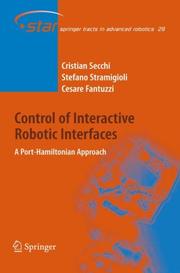
ISBN: 9783540497127 3540497129 9786610853014 1280853018 3540497153 Year: 2007 Publisher: Berlin, Heidelberg : Springer Berlin Heidelberg : Imprint: Springer,
Abstract | Keywords | Export | Availability | Bookmark
 Loading...
Loading...Choose an application
- Reference Manager
- EndNote
- RefWorks (Direct export to RefWorks)
When two physical systems (e.g. a robot and its environment) interact they exchange energy through localized ports and, in order to control their interaction, it is necessary to control the exchanged energy. The port-Hamiltonian formalism provides a general framework for modeling physical systems based on the concepts of energy, interconnection and power ports which describe the phenomena of energy storage, energy exchange and external interaction respectively. This monograph deals with energy based control of interactive robotic interfaces and the port-Hamiltonian framework is exploited both for modeling and controlling interactive robotic interfaces. Using the port-Hamiltonian framework, it is possible to identify the energetic properties that have to be controlled in order to achieve a desired interactive behavior and it is possible to build a port-Hamiltonian controller that properly regulates the robotic interface by shaping its energetic properties. Thanks to its generality, the port-Hamiltonian formalism allows to model and control also complex interactive robotic interfaces in a very natural way. In this book, a port-Hamiltonian approach for regulating the interaction between a robot and a local environment, a virtual environment (i.e. haptic interfaces) and a remote environment (i.e. bilateral telemanipulation systems) is developed.
Robots --- Tactile sensors. --- Control systems. --- Systèmes de commande --- Electronic books. -- local. --- Robots -- Control systems. --- Automatic control --- Tactile sensors --- Mechanical Engineering - General --- Mechanical Engineering --- Engineering & Applied Sciences --- Control systems --- Mathematical models --- Information Technology --- Artificial Intelligence --- Force sensors --- Touch sensors --- Robot control --- Engineering. --- Artificial intelligence. --- System theory. --- Control engineering. --- Robotics. --- Mechatronics. --- Control, Robotics, Mechatronics. --- Artificial Intelligence (incl. Robotics). --- Systems Theory, Control. --- Mechanical engineering --- Microelectronics --- Microelectromechanical systems --- Automation --- Machine theory --- Control engineering --- Control equipment --- Control theory --- Engineering instruments --- Programmable controllers --- Systems, Theory of --- Systems science --- Science --- AI (Artificial intelligence) --- Artificial thinking --- Electronic brains --- Intellectronics --- Intelligence, Artificial --- Intelligent machines --- Machine intelligence --- Thinking, Artificial --- Bionics --- Cognitive science --- Digital computer simulation --- Electronic data processing --- Logic machines --- Self-organizing systems --- Simulation methods --- Fifth generation computers --- Neural computers --- Construction --- Industrial arts --- Technology --- Philosophy --- Detectors --- Robotics --- Systems theory. --- Artificial Intelligence. --- Mathematical models. --- Automation. --- Control theory. --- Control, Robotics, Automation. --- Systems Theory, Control . --- Dynamics --- Automatic factories --- Automatic production --- Computer control --- Engineering cybernetics --- Factories --- Industrial engineering --- Mechanization --- Assembly-line methods --- Automatic machinery --- CAD/CAM systems
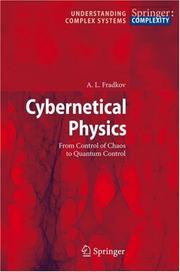
ISBN: 9783540462750 3540462759 9786610949519 1280949511 3540462775 Year: 2007 Publisher: Berlin ; Heidelberg ; New York : Springer,
Abstract | Keywords | Export | Availability | Bookmark
 Loading...
Loading...Choose an application
- Reference Manager
- EndNote
- RefWorks (Direct export to RefWorks)
The control of complex systems is one of the most important aspects in dealing with systems exhibiting nonlinear behaviour or similar features that defy traditional control techniques. This specific subject is gradually becoming known as cybernetical physics, borrowing methods from both theoretical physics and control engineering. This book is, perhaps, the first attempt to present a unified exposition of the subject and methodology of cybernetical physics as well as solutions to some of its problems. Emphasis of the book is on the examination of fundamental limits on energy transformation by means of control procedures in both conservative and dissipative systems. A survey of application in physics includes the control of chaos, synchronisation of coupled oscillators, pendulum chains, reactions in physical chemistry and of quantum systems such as the dissociation of diatomic molecules. This book has been written having researchers from various backgrounds in physics, mathematics and engineering in mind and is thus also suitable as introduction to graduate students working on the understanding of a broad range of complex systems in the natural sciences.
Nonlinear control theory. --- Commande non linéaire --- Complexity. --- Systems theory, Control. --- Nonlinear control theory --- Civil & Environmental Engineering --- Engineering & Applied Sciences --- Operations Research --- Physics. --- System theory. --- Elementary particles (Physics). --- Quantum field theory. --- Statistical physics. --- Dynamical systems. --- Vibration. --- Dynamics. --- Elementary Particles, Quantum Field Theory. --- Statistical Physics, Dynamical Systems and Complexity. --- Vibration, Dynamical Systems, Control. --- Systems Theory, Control. --- Dynamical systems --- Kinetics --- Mathematics --- Mechanics, Analytic --- Force and energy --- Mechanics --- Physics --- Statics --- Cycles --- Sound --- Mathematical statistics --- Relativistic quantum field theory --- Field theory (Physics) --- Quantum theory --- Relativity (Physics) --- Elementary particles (Physics) --- High energy physics --- Nuclear particles --- Nucleons --- Nuclear physics --- Systems, Theory of --- Systems science --- Science --- Natural philosophy --- Philosophy, Natural --- Physical sciences --- Dynamics --- Statistical methods --- Philosophy --- Control theory --- Nonlinear theories --- Quantum theory. --- Complex Systems. --- Statistical Physics and Dynamical Systems. --- Quantum dynamics --- Quantum mechanics --- Quantum physics --- Thermodynamics --- Systems theory.

ISBN: 1852336943 9780857293985 9781852336943 0857293982 Year: 2007 Publisher: London : Springer London : Imprint: Springer,
Abstract | Keywords | Export | Availability | Bookmark
 Loading...
Loading...Choose an application
- Reference Manager
- EndNote
- RefWorks (Direct export to RefWorks)
From power plants to sugar refining, model predictive control (MPC) schemes have established themselves as the preferred control strategies for a wide variety of processes. The second edition of Model Predictive Control provides a thorough introduction to theoretical and practical aspects of the most commonly used MPC strategies. It bridges the gap between the powerful but often abstract techniques of control researchers and the more empirical approach of practitioners. Model Predictive Control demonstrates that a powerful technique does not always require complex control algorithms. The text features material on the following subjects: general MPC elements and algorithms; commercial MPC schemes; generalized predictive control multivariable, robust, constrained nonlinear and hybrid MPC; fast methods for MPC implementation; applications. All of the material is thoroughly updated for the second edition with the chapters on nonlinear MPC, MPC and hybrid systems and MPC implementation being entirely new. Many new exercises and examples have also have also been added throughout and MATLAB® programs to aid in their solution can be downloaded from extras.springer.com. The text is an excellent aid for graduate and advanced undergraduate students and will also be of use to researchers and industrial practitioners wishing to keep abreast of a fast-moving field.
Predictive control. --- Modelvorming --- Optimalisering --- Procesregeling --- Stochastische processen --- Modelvorming. --- Optimalisering. --- Procesregeling. --- Stochastische processen. --- Systems Theory, Control. --- Systems theory. --- Predictive control --- Model based predictive control --- Model predictive control --- Engineering. --- Chemical engineering. --- System theory. --- Control engineering. --- Electronics. --- Microelectronics. --- Control. --- Industrial Chemistry/Chemical Engineering. --- Electronics and Microelectronics, Instrumentation. --- Microminiature electronic equipment --- Microminiaturization (Electronics) --- Electronics --- Microtechnology --- Semiconductors --- Miniature electronic equipment --- Electrical engineering --- Physical sciences --- Control engineering --- Control equipment --- Control theory --- Engineering instruments --- Automation --- Programmable controllers --- Systems, Theory of --- Systems science --- Science --- Chemistry, Industrial --- Engineering, Chemical --- Industrial chemistry --- Engineering --- Chemistry, Technical --- Metallurgy --- Construction --- Industrial arts --- Technology --- Philosophy --- Control and Systems Theory. --- Control theory. --- Chemistry, Technical. --- Systems Theory, Control . --- Industrial Chemistry. --- Dynamics --- Machine theory --- Chemical technology --- Technical chemistry --- Chemistry --- Chemical engineering
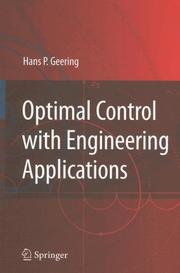
ISBN: 1280817720 9786610817726 3540694382 3540694374 Year: 2007 Publisher: Berlin : Springer,
Abstract | Keywords | Export | Availability | Bookmark
 Loading...
Loading...Choose an application
- Reference Manager
- EndNote
- RefWorks (Direct export to RefWorks)
Because the theoretical part of the book is based on the calculus of variations, the exposition is very transparent and requires mostly a trivial mathematical background. In the case of open-loop optimal control, this leads to Pontryagin’s Minimum Principle and, in the case of closed-loop optimal control, to the Hamilton-Jacobi-Bellman theory which exploits the principle of optimality. Many optimal control problems are solved completely in the body of the text. Furthermore, all of the exercise problems which appear at the ends of the chapters are sketched in the appendix. The book also covers some material that is not usually found in optimal control text books, namely, optimal control problems with non-scalar-valued performance criteria (with applications to optimal filtering) and Lukes’ method of approximatively-optimal control design. Furthermore, a short introduction to differential game theory is given. This leads to the Nash-Pontryagin Minimax Principle and to the Hamilton-Jacobi-Nash theory. The reason for including this topic lies in the important connection between the differential game theory and the H-control theory for the design of robust controllers.
Engineering. --- System theory. --- Computational intelligence. --- Control engineering. --- Robotics. --- Mechatronics. --- Control. --- Computational Intelligence. --- Systems Theory, Control. --- Control, Robotics, Mechatronics. --- Mechanical engineering --- Microelectronics --- Microelectromechanical systems --- Automation --- Machine theory --- Control engineering --- Control equipment --- Control theory --- Engineering instruments --- Programmable controllers --- Intelligence, Computational --- Artificial intelligence --- Soft computing --- Systems, Theory of --- Systems science --- Science --- Construction --- Industrial arts --- Technology --- Philosophy --- Control theory. --- Machine theory. --- Abstract automata --- Abstract machines --- Automata --- Mathematical machine theory --- Algorithms --- Logic, Symbolic and mathematical --- Recursive functions --- Robotics --- Dynamics --- Control and Systems Theory. --- Systems theory.
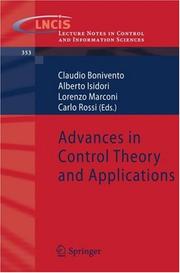
ISBN: 9783540707004 354070700X 9786610940684 1280940689 3540707018 Year: 2007 Publisher: Berlin, Germany ; New York, New York : Springer,
Abstract | Keywords | Export | Availability | Bookmark
 Loading...
Loading...Choose an application
- Reference Manager
- EndNote
- RefWorks (Direct export to RefWorks)
Control theory --- Automatic control --- Intelligent control systems --- Théorie de la commande --- Commande automatique --- Commande intelligente --- Congresses. --- Congrès --- Automatic control -- Congresses. --- Control theory -- Congresses. --- Electronic books. -- local. --- Intelligent control systems -- Congresses. --- Civil & Environmental Engineering --- Engineering & Applied Sciences --- Operations Research --- Engineering. --- System theory. --- Control engineering. --- Robotics. --- Mechatronics. --- Control. --- Control, Robotics, Mechatronics. --- Systems Theory, Control. --- Control and Systems Theory. --- Systems, Theory of --- Systems science --- Science --- Philosophy --- Systems theory. --- Mechanical engineering --- Microelectronics --- Microelectromechanical systems --- Automation --- Machine theory --- Control engineering --- Control equipment --- Engineering instruments --- Programmable controllers
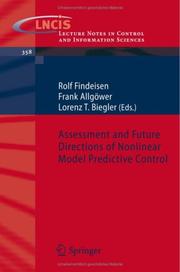
ISBN: 9783540726982 3540726985 3540726993 Year: 2007 Publisher: Berlin, Germany ; New York, New York : Springer,
Abstract | Keywords | Export | Availability | Bookmark
 Loading...
Loading...Choose an application
- Reference Manager
- EndNote
- RefWorks (Direct export to RefWorks)
Thepastthree decadeshaveseenrapiddevelopmentin the areaofmodelpred- tive control with respect to both theoretical and application aspects. Over these 30 years, model predictive control for linear systems has been widely applied, especially in the area of process control. However, today’s applications often require driving the process over a wide region and close to the boundaries of - erability, while satisfying constraints and achieving near-optimal performance. Consequently, the application of linear control methods does not always lead to satisfactory performance, and here nonlinear methods must be employed. This is one of the reasons why nonlinear model predictive control (NMPC) has - joyed signi?cant attention over the past years,with a number of recent advances on both the theoretical and application frontier. Additionally, the widespread availability and steadily increasing power of today’s computers, as well as the development of specially tailored numerical solution methods for NMPC, bring thepracticalapplicabilityofNMPCwithinreachevenforveryfastsystems.This has led to a series of new, exciting developments, along with new challenges in the area of NMPC.
Predictive control --- Nonlinear control theory --- Commande non linéaire --- Congresses. --- Congrès --- Mechanical Engineering - General --- Mechanical Engineering --- Engineering & Applied Sciences --- Model based predictive control --- Model predictive control --- Engineering. --- System theory. --- Control engineering. --- Robotics. --- Mechatronics. --- Control, Robotics, Mechatronics. --- Systems Theory, Control. --- Automatic control --- Systems, Theory of --- Systems science --- Science --- Philosophy --- Systems theory. --- Mechanical engineering --- Microelectronics --- Microelectromechanical systems --- Automation --- Machine theory --- Control engineering --- Control equipment --- Control theory --- Engineering instruments --- Programmable controllers
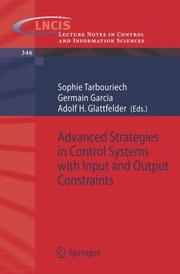
ISBN: 9783540370093 3540370099 9786610955565 1280955562 3540370102 Year: 2007 Volume: 346 Publisher: Berlin, Germany ; New York, New York : Springer,
Abstract | Keywords | Export | Availability | Bookmark
 Loading...
Loading...Choose an application
- Reference Manager
- EndNote
- RefWorks (Direct export to RefWorks)
Physical, safety or technological constraints induce that the control actuators can neither provide unlimited amplitude signals nor unlimited speed of reaction. The control problems of combat aircraft prototypes and satellite launchers offer interesting examples of the difficulties due to these major constraints. Neglecting actuator saturations on both amplitude and dynamics can be source of undesirable or even catastrophic behavior for the closed-loop system (such as loosing closed-loop stability). Such actuator saturations have also been blamed as one of several unfortunate mishaps leading to the 1986 Chernobyl nuclear power plant disaster. For these reasons, the study of the control problem (its structure, performance and stability analysis) for systems subject to both amplitude and rate actuator or sensor saturations as typical constraints has received the attention of many researchers in the last years. The different techniques described throughout the book are particularly attractive for industrial applications not only in aeronautical or space domains but also in the context of biological systems domain. Such methods are well suited for the development of tools that help engineers to solve analysis and synthesis problems in the context of control systems with input and output constraints.
Input-output-modellen. --- Controlesystemen. --- Automatic control --- Control theory --- Commande automatique --- Théorie de la commande --- Automatic control. --- Control theory. --- Electronic books. -- local. --- Mechanical Engineering --- Engineering & Applied Sciences --- Mechanical Engineering - General --- Control engineering --- Control equipment --- Engineering. --- System theory. --- Control engineering. --- Robotics. --- Mechatronics. --- Control, Robotics, Mechatronics. --- Systems Theory, Control. --- Dynamics --- Machine theory --- Engineering instruments --- Automation --- Programmable controllers --- Systems theory. --- Systems, Theory of --- Systems science --- Science --- Philosophy --- Mechanical engineering --- Microelectronics --- Microelectromechanical systems
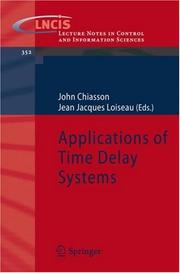
ISBN: 9783540495550 354049555X 9786610853007 128085300X 3540495568 Year: 2007 Volume: v. 352 Publisher: Berlin, Germany ; London, England : Springer,
Abstract | Keywords | Export | Availability | Bookmark
 Loading...
Loading...Choose an application
- Reference Manager
- EndNote
- RefWorks (Direct export to RefWorks)
Time delay systems --- Systèmes à retard --- Automatic control. --- Time delay systems. --- Automatic control --- Mechanical Engineering --- Engineering & Applied Sciences --- Mechanical Engineering - General --- Time delay control --- Time delay control systems --- Time delay controllers --- Time-delayed systems --- Control engineering --- Control equipment --- Engineering. --- System theory. --- Control engineering. --- Robotics. --- Mechatronics. --- Control, Robotics, Mechatronics. --- Systems Theory, Control. --- Feedback control systems --- Process control --- Control theory --- Engineering instruments --- Automation --- Programmable controllers --- Systems theory. --- Systems, Theory of --- Systems science --- Science --- Philosophy --- Mechanical engineering --- Microelectronics --- Microelectromechanical systems --- Machine theory
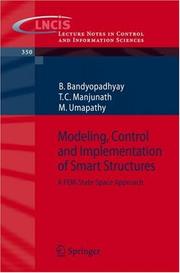
ISBN: 9783540483939 3540483934 9786610853328 1280853328 3540483942 Year: 2007 Volume: v. 350 Publisher: Berlin, Germany ; New York, United States : Springer,
Abstract | Keywords | Export | Availability | Bookmark
 Loading...
Loading...Choose an application
- Reference Manager
- EndNote
- RefWorks (Direct export to RefWorks)
This monograph presents an introductory overview of smart structures, their concepts, their active involvement in the vibration control, their applications and the extensive research work done on it so far. The modelling of flexible beams using two types of beam theories, viz., the Euler-Bernoulli theory and the Timoshenko beam theory is presented, including a new concept of finite element modeling of the flexible structures using Timoshenko beam theory with the inclusion of the shear both in the piezo-patches as well as in the host structure. It presents the design of the periodic output feedback control system for smart structure systems, the design of the FOS controllers for active vibration control and the design of Discrete Sliding Mode controllers using multirate output feedback technique. This monograph is based on the authors work on the multirate output sampling techniques (FOS and POF) and the multirate output feedback based discrete-time sliding mode control of flexible beams with simulations performed in Matlab. The hardware implementation of some of the developed control algorithms is depicted using DSpace and Real Time Workshop.
Smart structures --- Structures intelligentes --- Electronic books. -- local. --- Smart structures. --- Structural control (Engineering). --- Civil Engineering --- Civil & Environmental Engineering --- Engineering & Applied Sciences --- Structural control (Engineering) --- Control of structures (Engineering) --- Adaptive structures --- Intelligent structures --- Engineering. --- System theory. --- Control engineering. --- Robotics. --- Mechatronics. --- Control, Robotics, Mechatronics. --- Systems Theory, Control. --- Structural dynamics --- Systems, Theory of --- Systems science --- Science --- Philosophy --- Systems theory. --- Mechanical engineering --- Microelectronics --- Microelectromechanical systems --- Automation --- Machine theory --- Control engineering --- Control equipment --- Control theory --- Engineering instruments --- Programmable controllers
| Listing 1 - 10 of 67 | << page >> |
Sort by
|

 Search
Search Feedback
Feedback About UniCat
About UniCat  Help
Help News
News